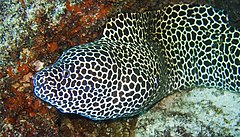Laced moray
| Laced moray | |
|---|---|

| |
| Scientific classification | |
| Domain: | Eukaryota |
| Kingdom: | Animalia |
| Phylum: | Chordata |
| Class: | Actinopterygii |
| Order: | Anguilliformes |
| Family: | Muraenidae |
| Genus: | Gymnothorax |
| Species: | G. favagineus
|
| Binomial name | |
| Gymnothorax favagineus Bloch & J. G. Schneider, 1801
| |
The laced moray (Gymnothorax favagineus), also known as the leopard moray, leopard moray eel, tessellate moray or honeycomb moray, is a species of marine fish in the family Muraenidae.
Description
[edit]Gymnothorax favagineus is a large moray which can reach a maximum length of 3 metres (10 feet), but specimens usually encountered are much smaller.[2]
Its body is serpentine in shape, with a white to yellowish background color dotted with numerous black spots. These spots vary in size and shape depending on the individual and on the environment in which the animals live:[3] morays living on a reef with clear water will have fewer black spots than those living in a turbid environment.[4] This characteristic color pattern is the source of its vernacular name.
Distribution and habitat
[edit]The laced moray is widespread throughout the Indo-West Pacific area from eastern coast of Africa, Red Sea included, to Papua New Guinea and from southern Japan to the Great Barrier Reef.[5][6]
It lives on the outer slopes of coral reefs. During the day, it sits sheltered in crevices between 1 and 45 meters (3 and 150 feet) deep.[7]
Diet and feeding habits
[edit]The laced moray is carnivorous. It leaves its lair at night to actively hunt its prey along the reef. It feeds mainly on small fish and cephalopods.[8] Large adults are prone to be aggressive in the wild.[9]
References
[edit]- ^ Smith, D.G.; McCosker, J.; Tighe, K. (2019). "Gymnothorax favagineus". IUCN Red List of Threatened Species. 2019: e.T195726A2408402.
- ^ Lieske, E. and R. Myers, 1994. Collins Pocket Guide. Coral reef fishes. Indo-Pacific & Caribbean including the Red Sea. Harper Collins Publishers, 400 p.
- ^ Kuiter, R.H., 1998. Photo guide to fishes of the Maldives. Atoll Editions, Victoria, Australia. 257 p.
- ^ Kuiter, R.H. and T. Tonozuka, 2001. Pictorial guide to Indonesian reef fishes. Part 1. Eels- Snappers, Muraenidae - Lutjanidae. Zoonetics, Australia. 302 p.
- ^ Fricke, R., 1999. Fishes of the Mascarene Islands (Réunion, Mauritius, Rodriguez): an annotated checklist, with descriptions of new species. Koeltz Scientific Books, Koenigstein, Theses Zoologicae, Vol. 31:759 p.
- ^ Lieske, E. and R. Myers, 1994. Collins Pocket Guide. Coral reef fishes. Indo-Pacific & Caribbean including the Red Sea. Harper Collins Publishers, 400 p.
- ^ "Gymnothorax favagineus | DORIS".
- ^ Sommer, C., W. Schneider and J.-M. Poutiers, 1996. FAO species identification field guide for fishery purposes. The living marine resources of Somalia. FAO, Rome. 376 p.
- ^ Lieske, E. and R. Myers, 1994. Collins Pocket Guide. Coral reef fishes. Indo-Pacific & Caribbean including the Red Sea. Harper Collins Publishers, 400 p.
External links
[edit]- Marinespecies.org: Gymnothorax favagineus
- Fishes of Australia : Gymnothorax favagineus
- "Gymnothorax favagineus". Integrated Taxonomic Information System. Retrieved 13 January 2015.
- Froese, Rainer; Pauly, Daniel (eds.). "Gymnothorax favagineus". FishBase. Retrieved 13 January 2015.
- Photos of Laced moray on Sealife Collection

